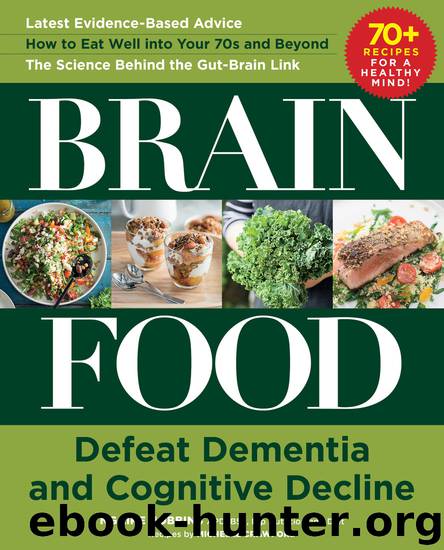Brain Food by Ngaire Hobbins

Author:Ngaire Hobbins
Language: eng
Format: epub
ISBN: 9781510754768
Publisher: Skyhorse
Published: 2019-08-08T16:00:00+00:00
In the fridge
Cheese, such as feta, cheddar, parmesan
Cheese is a high-protein food that supplies plenty of calcium. Some types, including “blue” varieties and any made from unpasteurized milk, also provide “good” bacteria to boost your gut health. It’s also an easy snack on a cracker, on a sandwich or on a ploughman’s platter. Cheese adds flavor to many dishes, and can be grated into soups and salads, used in an omelette, or scattered over pasta dishes or baked sweet potato to add extra protein and calcium.
Butter (versus margarine)
You have read in Chapter 5 that foods which have undergone the fewest steps between their original source and the way they are eaten tend to help reduce chronic inflammation. This argument might be offered when it comes to butter, as it certainly has undergone far fewer steps in production than margarine. Butter contains antioxidants and adds flavor when cooking. Mixing it with olive oil if sautéeing or browning combines the flavor of butter with the anti-inflammatory benefits of the oil, which also stops the butter from burning.
Yogurt
Greek-style yogurt is the same as any other yogurt, but some of the liquid whey is strained off so it is thicker and more concentrated. It’s always important to look for labeling that specifies “live cultures” or “probiotic” or lists the bacteria the yogurt contains; that way you know you are getting the goodness of the brain-assisting gut bacteria. Not only that, but yogurt has a lovely flavor and can be used in both sweet and savory dishes. Add it to soups, make a dip, or serve it with stewed fruits.
Oils, such as walnut oil, extra virgin olive oil, cold-pressed sesame oil, flaxseed (linseed) oil, macadamia oil, rice bran oil
The “good” fats in these oils are so important for your brain that it is worth buying the best you can afford. “First cold-pressed” and “extra virgin” designate premium (usually produced in smaller amounts, so more expensive) oils. Have a couple of types on hand: I suggest using premium oils to drizzle over veggies, in salads, to dip good bread in or to make dips and snacks. Keep less expensive oils for cooking: all oil gives a great anti-inflammatory boost for just a few extra calories.
Some oils can be heat-sensitive and need to be stored in the fridge: these include walnut, flaxseed and macadamia oils. Olive oil and rice bran oil are shelf stable. If you store olive oil in the fridge, it may solidify; stand it on the shelf for a while before use and it’s back to liquid.
Tahini
A paste made of ground sesame seeds, tahini contains the nutritional goodness of sesame seeds, which, like all seeds, are high in protein, contain fats good for the body and brain, and supply a variety of essential vitamins and minerals, including calcium. Store tahini in the fridge to help the oil it contains stay fresh.
Green (and red) salad leaves
The cornerstone of any nutritious diet, a bag of prewashed leafy greens, a bunch of kale, or a romaine lettuce is the foundation for so many meals and lots of recipes in this book.
Download
This site does not store any files on its server. We only index and link to content provided by other sites. Please contact the content providers to delete copyright contents if any and email us, we'll remove relevant links or contents immediately.
| Cheese & Dairy | Chocolate |
| Fish & Seafood | Fruits |
| Herbs, Spices & Condiments | Meat & Game |
| Natural Foods | Pasta & Noodles |
| Potatoes | Poultry |
| Rice & Grains | Vegetables |
The Sprouting Book by Ann Wigmore(3543)
Better Homes and Gardens New Cookbook by Better Homes & Gardens(3525)
Trullo by Tim Siadatan(3379)
Super Food Family Classics by Jamie Oliver(3367)
Hedgerow by John Wright(3275)
Panini by Carlo Middione(3250)
Bread Revolution by Peter Reinhart(3083)
Sauces by James Peterson(3051)
Jam by Jam (epub)(3023)
Ottolenghi - The Cookbook by Yotam Ottolenghi(2871)
Oh She Glows Every Day by Angela Liddon(2728)
My Pantry by Alice Waters(2543)
Hot Sauce Nation by Denver Nicks(2450)
The Culinary Herbal by Susan Belsinger(2430)
Veg by Jamie Oliver(2410)
Wanderlust by Jeff Krasno(2225)
Meathooked by Marta Zaraska(2220)
The Art of Making Gelato by Morgan Morano(2216)
Basic Illustrated Edible and Medicinal Mushrooms by Jim Meuninck(2187)
